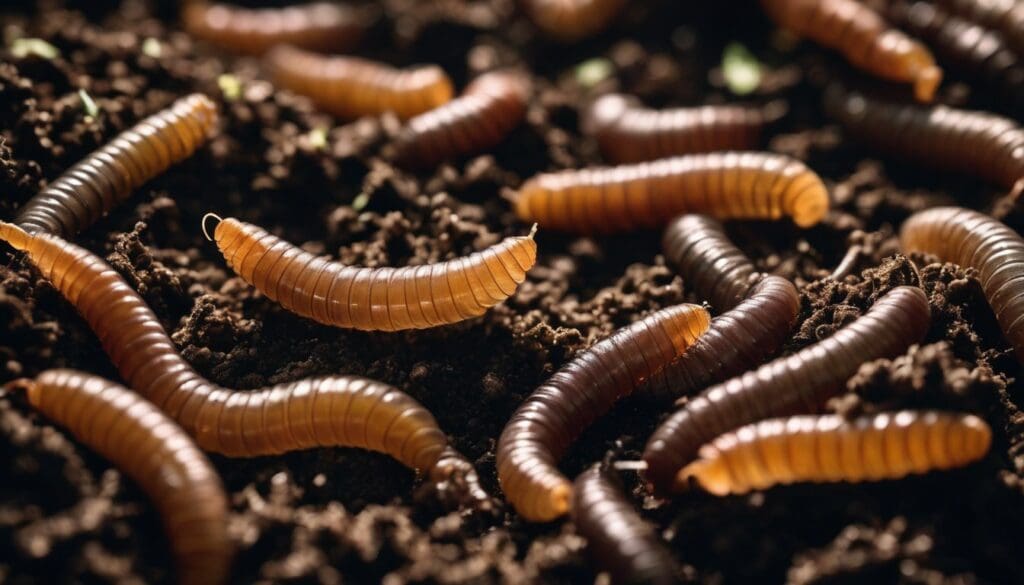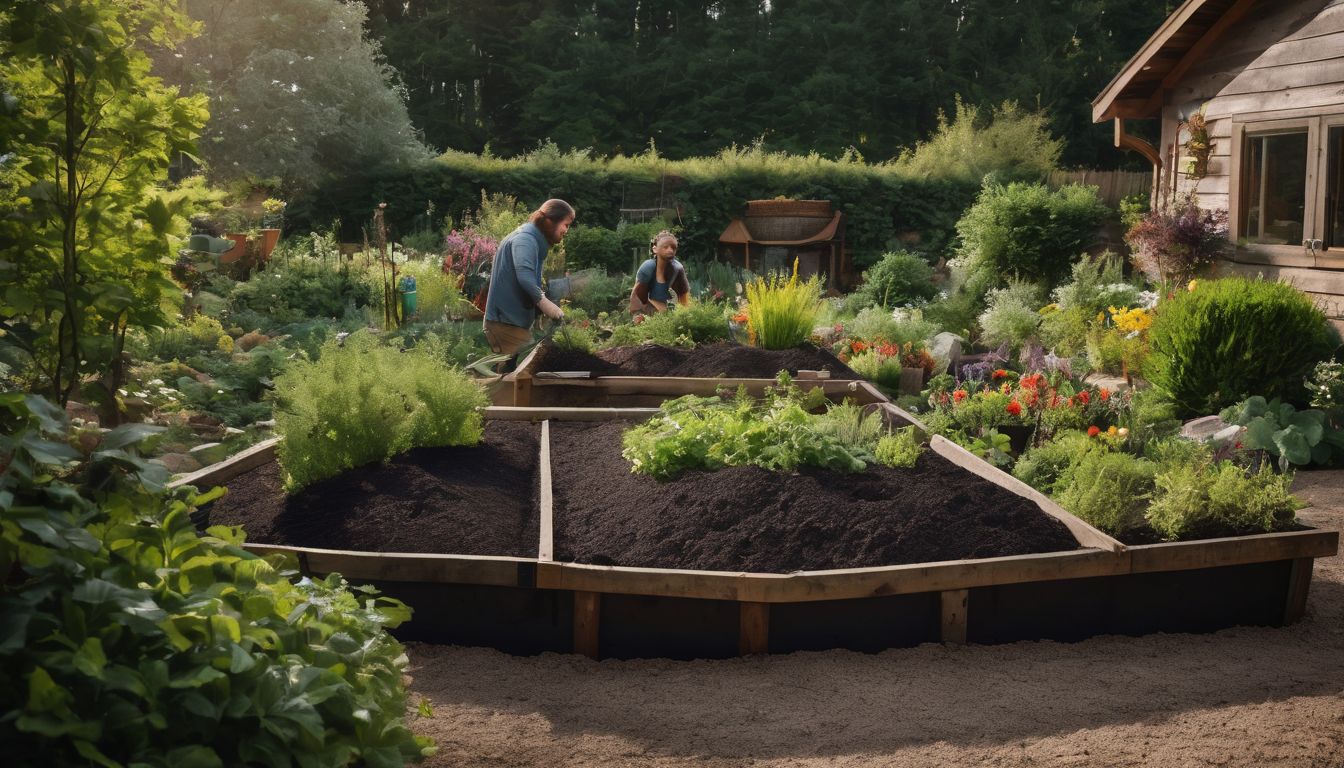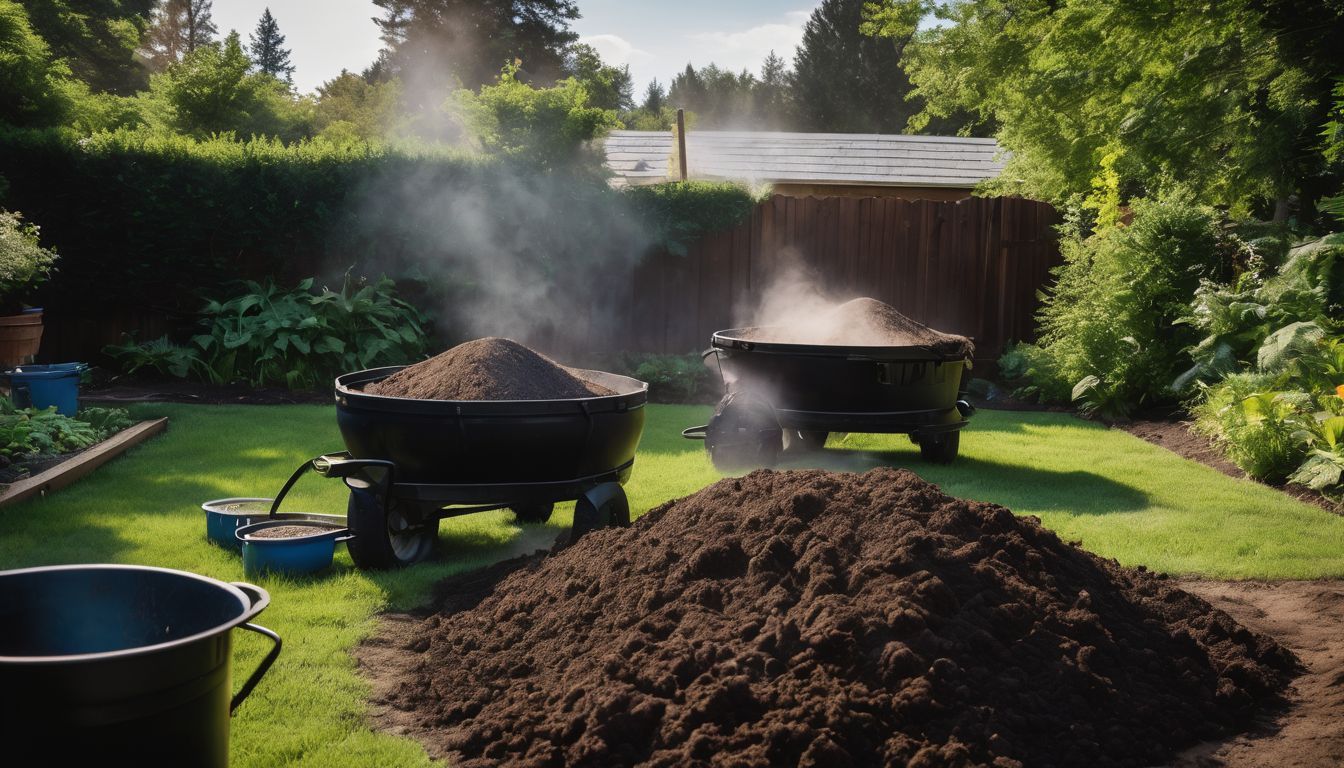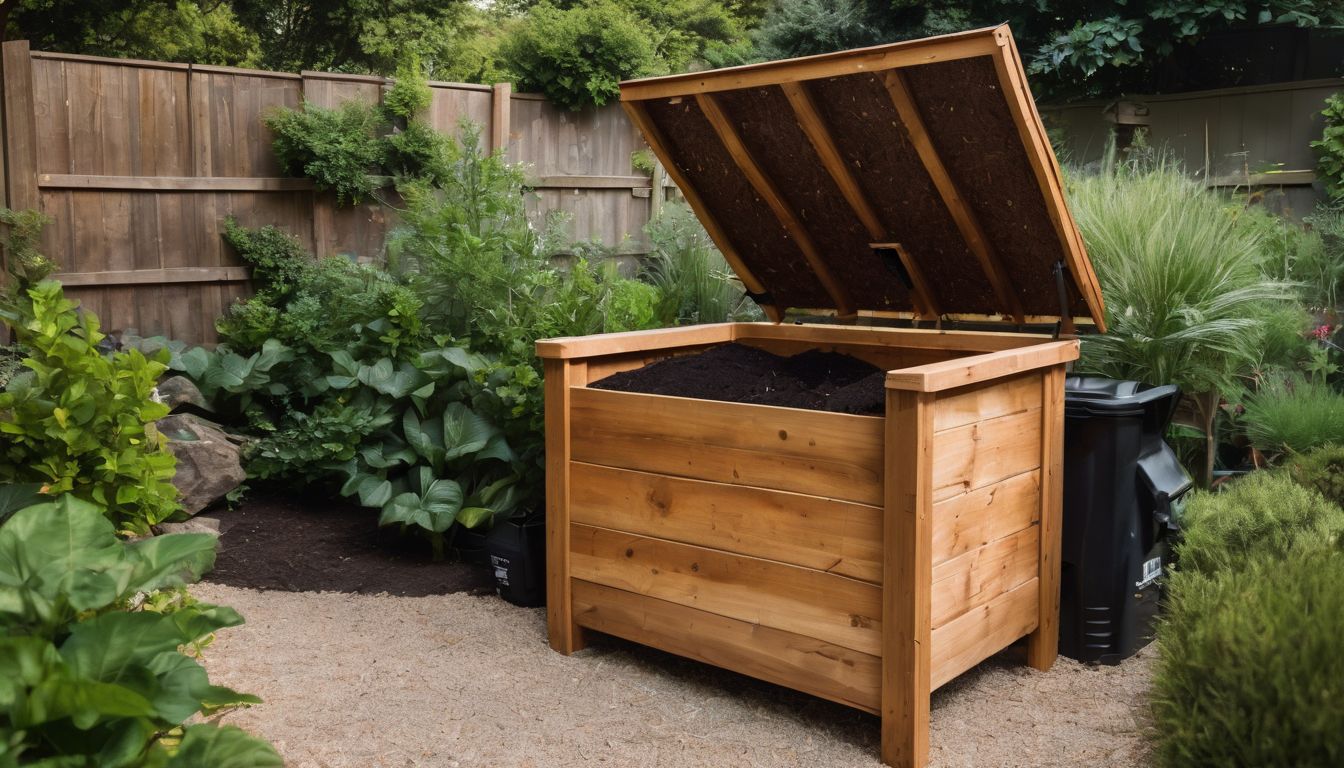Struggling with piles of kitchen scraps? Worm composting transforms this waste into a powerhouse for your garden. Our guide will show you how to turn food leftovers into nutrient-rich soil through the magic of worm farming.
Dive in and give your plants a feast!
Key Takeaways
- Worm composting, or vermicomposting, uses worms such as red wigglers and European nightcrawlers to turn kitchen scraps into rich soil that is excellent for gardens.
- This method of composting accelerates the decomposition process, enriches the soil with essential nutrients like nitrogen, phosphorus, and potassium, and enhances its structure for better plant growth.
- Vermicomposting is eco – friendly; it reduces methane emissions from landfills by recycling organic waste at home and decreases reliance on chemical fertilisers through natural nutrient cycling.
- Careful maintenance of the worm bin includes feeding appropriate scraps, avoiding materials harmful to worms like citrus and meats, regulating moisture levels, adding amendments such as crushed eggshells or coffee grounds, and harvesting the finished compost using several methods.
- Utilising worm compost in gardens improves water retention in soil structures while boosting plant health naturally due to its high nutrient content. It also fosters a diverse microbial environment which can lead to disease suppression and natural pest control.
What Is Worm Composting?
Worm composting, also known as vermicomposting, is the process of using worms to break down organic matter into nutrient-rich soil. It offers numerous benefits and can be done with different types of worms and simple materials.
Benefits of vermicomposting
- Speeds up decomposition: Worms break down organic matter faster than traditional composting methods. They consume food waste and produce castings, which enrich the soil.
- Enhances nutrient availability: The worm castings add vital nutrients back into the earth. These nutrients include nitrogen, phosphorus, and potassium, essential for plant growth.
- Improves soil structure: Castings from worms improve soil aeration and water retention. Plants can better withstand drought with this improved environment.
- Reduces greenhouse gases: By composting with worms, you prevent organic waste from ending up in landfills where it would emit methane.
- Encourages beneficial microbes: The microbial population in worm compost is diverse and aids in further breakdown of materials into plant-available forms.
- Saves money on fertilisers: Using vermicompost reduces the need for chemical fertilisers, leading to savings and environmental benefits.
- Teaches responsibility: Managing a worm bin involves regular care and maintenance, fostering a sense of stewardship over one’s waste.
Types of worms used
After learning about the benefits of vermicomposting, it’s important to understand the types of worms used in this process. There are three main types of worms suitable for vermicomposting: red wigglers (Eisenia fetida), Indian blue worms (Perionyx excavatus), and European nightcrawlers (Eisenia hortensis). Each worm species has unique characteristics that make them ideal for breaking down organic materials in compost bins.
- Red Wigglers (Eisenia fetida): These worms are popular choices for vermicomposting due to their voracious appetites and ability to rapidly consume organic waste. They thrive in the confines of a compost bin and are adept at converting food scraps into nutrient-rich castings.
- Indian Blue Worms (Perionyx excavatus): Known for their high reproduction rate, these tropical worms are excellent at breaking down organic matter quickly while withstanding warm temperatures. Their ability to process a large quantity of organic waste makes them an efficient choice for vermiculture in warmer climates.
- European Nightcrawlers (Eisenia hortensis): Resilient and adaptable, these larger worms can tolerate varying conditions and thrive in both outdoor and indoor compost setups. They excel at aerating the bedding material with their burrowing activity, which facilitates the decomposition process.
Necessary materials
To set up a successful worm composting bin, you will need the following materials:
- A suitable container: Find a well-ventilated plastic or wooden bin with a lid.
- Bedding material: Use shredded newspaper, cardboard, or coconut coir to create a comfortable environment for the worms.
- Redworms: Red wigglers or red composting worms are ideal for vermicomposting.
- Moisture control: Keep a spray bottle handy for moistening the bedding if it becomes too dry.
- Food scraps: Collect fruit and vegetable scraps to feed your worms, avoiding citrus and onions.
- Aeration tool: Use a small hand rake or fork to aerate the bedding regularly.
Setting Up Your Worm Composting Bin
Designing and elevating your bin, choosing the right bedding, and placing the bin in an ideal location are crucial steps to ensure a successful vermicomposting system. These factors will contribute to creating the perfect environment for your worms to thrive and turn food waste into nutrient-rich compost.
Bin design and elevation
To design an effective worm composting bin, ensure it has proper ventilation to allow airflow. Elevation is crucial – place the bin on bricks or blocks to avoid waterlogging and facilitate drainage.
A sturdy lid can protect from pests while allowing necessary air circulation.
Consider using a plastic storage container with drilled holes for a DIY option, or invest in a purpose-built worm composter with multiple trays for easy harvesting. By elevating the bin and designing it with the right materials, you create an optimal environment for your worms’ composting activities, ensuring successful nutrient transfer and efficient food waste recycling.
Choosing the right bedding
When setting up your worm composting bin, the choice of bedding is crucial for creating a suitable environment for the worms. Here’s how to choose the right bedding:
- Use shredded newspaper or cardboard as bedding material to provide a soft and absorbent environment for the worms.
- Avoid glossy or colored paper which may contain harmful chemicals.
- Dampen the bedding slightly before adding it to the bin to create a moist but not soggy environment.
- Ensure that the bedding is fluffy and loose to allow for air circulation within the composting bin.
- Consider adding a small amount of soil to introduce beneficial microorganisms into the composting environment.
- Monitor the moisture levels regularly and add more bedding if needed to maintain the ideal moisture balance for your worms.
Placement of the bin
After choosing the right bedding for your worm composting bin, the next crucial step is to ensure its proper placement. The bin should be placed in a shaded area that’s protected from extreme weather conditions.
A garage or a sheltered outdoor spot can work well. Keep the bin off the ground using bricks or blocks to prevent waterlogging and provide good airflow, which is essential for your worms’ health.
It’s important to keep the location of your bin in mind as you’ll need easy access for feeding and monitoring without causing undue disturbance to their environment. In addition, proximity to where you plan on using the finished compost will also save time and effort when it comes time to harvest it.
Caring for Your Worms
Keep your worms happy and healthy by regularly feeding them with organic kitchen waste, adding amendments like crushed eggshells or coffee grounds for a thriving compost, and using the right harvesting methods to ensure a successful vermicomposting process.
Read more about the important role of worms in composting in our blog!
Feeding your worms
To feed your worms, add vegetable and fruit scraps to the bin. Ensure these are chopped finely to aid in decomposition. Include items such as coffee grounds, tea bags, and crushed eggshells for added nutrients. Avoid adding dairy products, meat, oily foods, or citrus fruits as these can create an imbalance in the bin.
Amendments for a thriving compost
To ensure a thriving compost, it’s essential to incorporate the right amendments to support the growth of beneficial microorganisms and create nutrient-rich soil.
- Add carbon – rich materials like shredded cardboard or paper to balance the nitrogen content from food scraps.
- Introduce small amounts of crushed eggshells for calcium and grit, aiding in the worms’ digestion process.
- Incorporate coffee grounds as a source of nitrogen and an energy boost for the worms.
- Sprinkle small amounts of rock dust to enhance mineral content in the compost.
- Utilise a mix of vegetable and fruit scraps, avoiding citrus and onions which can be harmful to worms.
Harvesting methods
Harvesting worm compost is a simple and rewarding process.
- Separation: Remove finished compost and worms by creating piles of bedding and separating the worms from the compost manually or through migration to one side of the bin.
- Natural Harvesting: Place fresh food on one side of the bin, which will naturally attract worms as they move towards the food, allowing you to harvest the compost from the other side.
- Screening: Use a fine mesh screen to sift out larger undecomposed materials, leaving behind rich, dark worm castings ready for use.
- Storing: Store harvested worm compost in a cool, dry place for future use as a potent organic fertiliser in gardens or landscapes.
Using Worm Compost
– Benefits in gardens and landscapes: Worm compost provides essential nutrients to soil, improves soil structure, and increases water retention for healthier plant growth.
– Troubleshooting common issues: Learn how to address potential problems such as odor, fruit flies, or excessive moisture when using worm compost in your garden or landscape.
Benefits in gardens and landscapes
Worm compost is an exceptional garden conditioner that enriches soil health and promotes plant growth. It enhances the structure of the soil, improves water retention, and increases nutrient availability for plants. Using worm compost in gardens and landscapes can also help to suppress diseases, control pests naturally, and reduce the need for chemical fertilisers. Additionally, it supports biodiversity by providing a habitat for beneficial microorganisms and earthworms.
- Enriches soil structure
- Improves water retention
- Increases nutrient availability for plants
- Suppresses diseases
- Controls pests naturally
- Reduces reliance on chemical fertilisers
- Supports biodiversity through habitat creation
Troubleshooting common issues
Troubleshooting common issues:
- Excessive moisture in the worm bin can be resolved by adding more bedding to absorb the excess liquid.
- If there is a foul smell, check the bin for overfeeding and remove any rotting food.
- Worms trying to escape indicate an unfavorable environment; adjust moisture levels and airflow.
- Fruit flies can be controlled by burying food scraps deeper within the bedding and covering them with fresh bedding.
- A decrease in worm population may signal poor conditions; review temperature, moisture, and food levels regularly.
References and resources
After troubleshooting common issues with your worm compost, it’s essential to have reliable references and resources for ongoing support. Seek guidance from reputable sources such as gardening websites, environmental organisations, and books by experts in vermicomposting.
The internet is a valuable tool too, providing access to forums and online communities where you can ask questions and share experiences with fellow environmentally conscious individuals.
Additionally, local conservation groups or eco-friendly stores may offer workshops or materials specific to worm composting.
Remember that the success of your composting journey also depends on staying informed about best practices and new developments in the field; keep an eye out for webinars, conferences, or publications related to sustainable waste management.
Conclusion
In conclusion, worms play a crucial role in composting by breaking down organic waste. They help create nutrient-rich worm castings that improve soil health. Using worm compost can enhance plant growth and support sustainable gardening practices.
Embracing vermicomposting is a small but impactful way to contribute to environmental conservation efforts.
FAQs
1. Why are worms important in composting?
Worms play a crucial role in composting by breaking down organic material, which speeds up the process and creates rich soil for gardens.
2. Can all types of worms be used for composting?
Not all worms are suitable for composting; red wigglers and other specific types are best because they thrive on organic waste.
3. What do worms eat when they’re in a compost bin?
In a compost bin, worms feast on kitchen scraps, leaves, and other decomposing natural materials turning them into nutrient-filled compost.
4. How do I know if my compost has enough worms?
You’ll know your compost has enough worms when you see plenty of worm activity throughout the pile and the organic matter breaks down quickly.





